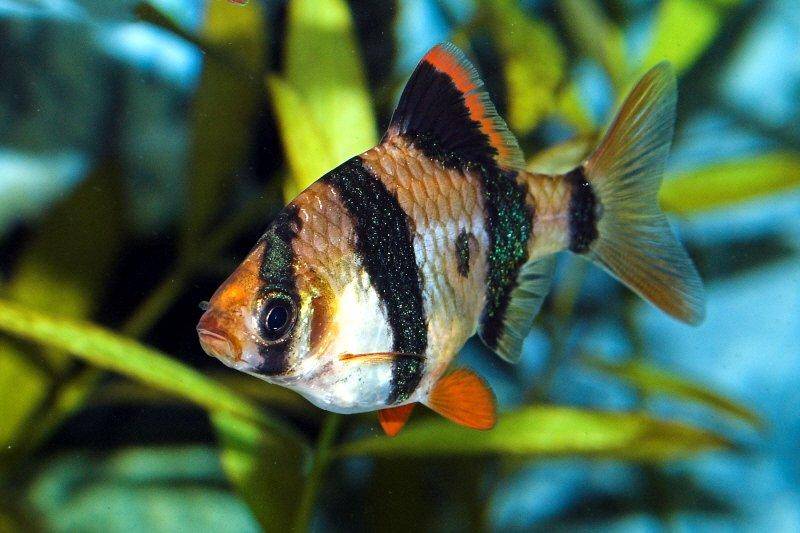Tiger barb
Female tiger barb
The tiger barb or four- bar belt ( cf. Puntigrus tetrazona ) is a scientifically undescribed freshwater fish in the order of the carp -like with an unknown distribution in Southeast Asia.
Features
The tiger barb has a high-backed, laterally strongly compressed and up to the head completely scaly body. The highest part of the body located between the neck of the dorsal fin and the rear end of the pelvic fins. Comprised of only eight to nine pores lateral line is incomplete; it starts at the top of the gill cover, ending in the third body binding, above the anal fin. The base color is a up to an olive tint varying beige. The belly is between the end of the gill cover and the approach of the pelvic fins pale beige to pale silvery. The distinctive scales are dark brown to black lined. Four wide, vertical bands encircle the body, are usually black, but can also shine grünmetallisch. The first runs over the eyes, the second is just before the dorsal and ventral fins, the third is a continuation of the dorsal fins and coloration extends to the anal fin, the last surrounds the neck of the tail fin.
The pectoral fins are red, rarely transparent and the first hard jet can be red. The pelvic fins are lined with red and transparent or black. The approach of the anal fin is colored like the body binding, the rear part is transparent, reddish or red. The homocerke tail fin is forked and bears at its top and bottom of a different intense red hem. The color of the steep, relatively high dorsal fin corresponds to the binding of the body and carries a wide red hem. The eye is dark pigmentation. The head, including the lips of the terminal jaw may be red; the upper lip is wearing a short filamentous Bartel pair. Males reach a total length of five females than seven centimeters.
Dissemination
Only two serious documented occurrences are known in Singapore and the Gunung Pulai Recreational Forest in the Malaysian state of Johor to the south of the Malay Peninsula. All other data dissemination in popular and scientific literature based on confusion with other species or they are based, if they are more recent, on the consequences of the widespread in Southeast Asia aquarium fish. On the large Sunda island of Sumatra tiger barb does not occur.
System
The Dutch doctor and ichthyologist Pieter Bleeker, who served as a medical officer in Indonesia from 1842 to 1860, described in 1855 a west by himself in South Sumatra, in today's Indonesian district Lahat, the city of Palembang, caught striated barbinen carp fish as Capoeta tetrazona. Two years later, in 1857, Bleeker described the same striated bar of the identical locality again as Systomus sumatrensis and changed its name in 1860 even in Systomus sumatranus (both synonyms for Puntius tetrazona ). In between, in 1857, he called another striated bar of the river Kahajan in southern Borneo Puntius tetrazona; this way, the Rhombenbarbe is now called Puntius rhomboocellatus. Another "Tiger bar " described Léon Vaillant 1904 by Borneo as Barbus anchisporus. It differs inter alia by the number of circumpeduncularen, the caudal peduncle that surround scales of Puntius tetrazona ( P. tetrazona: 12; P. anchisporus: 14). And in 1934 described Fowler Barbus partipentazona of Kratt in south-eastern Thailand. With all these scientific species names, the tiger barb has already been linked, to Klausewitz 1955 the species name Puntius tetrazona manifested. Since then, the tiger barb wore this style name in almost all scientific and popular publications. The fact that Kottelat, Whitten, Kartikasari and Wirjoatmodjo 1993 Puntius tetrazona the Formalinpräparat a striated bar is shown with black pelvic fins, no one noticed. In 2007, for the first time hunting and living a striated bar of Borneo to Germany imported that has completely black colored dorsal, anal and pelvic fins. Axel Zarske, Senckenberg Natural History Collections Dresden, deterministic as this fish Puntius tetrazona, from which you now know that it occurs in Sumatra and Borneo. Zarske now compared all known striated Barben, concluding that the tiger barb no way already described scientifically can be assigned.
Because of their similarity and decades of confusion with Puntius tetrazona, the tiger barb Puntius cf as was referred tetrazona ( cf: the Latin verb conferre means " to gather "). In November 2013, the Swiss ichthyologist Maurice Kottelat assigned to all Southeast Asian " tiger barbs " of the newly established genus Puntigrus.
Relevance to humans
Since its first introduction to Europe, most likely in 1933 by the import company Otto Winckelmann, Hamburg- Altona, the tiger barb one of the world's most commonly traded aquarium fish. In Southeast Asia (Thailand, Malaysia, Singapore), the United States, Canada, Israel and the Czech Republic it is increasingly a million times for this purpose. Depending on the breeding line and method of varying the intensity of the body color and the achievable overall length. The appearance is always unmistakable. There are under various trade names flat green colored ( " Moss green bar " ), leucistische ( " Hong Kong - bar " ), albino and xanthoristische breeds and, in addition, hybrids of these cultivated forms with the Ursprungsart and a leucistische variant without operculum.










